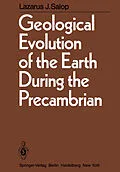Progress in Precambrian geology has been exceptionally great, indeed quite striking for geologists of the older generation; only some 30-40 years ago the Precambrian appeared as an uncertain and even mystic prelude to geologic evolution. Even the very name - Precambrian - means some indi visible unit in the early history of the Earth, the beginning of which is poorly known. At the same time it was obvious that the Precambrian formations are of extremely varied and complex composition and poor knowledge and lack of reliable methods of division and correlation were to blame for the lack of significant progress in studies of this early evolutionary stage of the planet. Certainly, even at the very start of Precambrian studies, the results obtained were quite promising, lifting as they did the mysterious veil over the regional Precambrian; but they presented no general realistic picture of this early stage in the Earth's evolution at that time. Recently, this situation has completely changed, due to new methods of study of the older forma tions, and due also to the refinement of some well-known methods, in particular of division, dating, and correlation of "silent" metamorphic strata. Application of different isotope methods of dating was most impor tant in providing objective rock age and thereby the age of geologic events recorded in these rocks. Thus it became possible to reconstruct the oldest geologic period of our planet.
Inhalt
1 General Problems in Division of the Precambrian.- I. Methods and Principles of the Precambrian Division.- 1. Paleontological Methods.- 2. Isotope (Radiometric) Methods.- 3. Geohistorical Methods.- II. Division of the Precambrian.- 1. Stratigraphic Units.- 2. Lithostratigraphic Units (Complexes).- 3. The Global Stratigraphic Scheme of the Precambrian.- 2 The Katarchean.- A. Rock Records.- 1. General Characteristics of the Katarchean.- 2. Stratotype of the Katarchean (the Aldan Group).- 3. The Lithostratigraphic Complexes of the Katarchean.- B. Geologic Interpretation of Rock Record.- 1. Age of the Beginning of the Katarchean Era.- 2. Physical Conditions on the Earth's Surface.- 3. Composition of Atmosphere and Hydrosphere.- 4. Sedimentation Environment.- 5. Life in the Katarchean.- 6. Genesis of Magmatic and Metamorphic Rocks.- 7. Tectonic Regime.- 8. Certain Features of the Earliest Stage in the Evolution of the Earth (the Stage of Cosmic Bombardment).- 9. Principal Stages of Geologic Evolution.- 3 The Paleoprotozoic (Archeoprotozoic).- A. Rock Records.- 1. General Characteristics of the Paleoprotozoic.- 2. The Paleoprotozoic Stratotype and Its Correlatives in Different Parts of the World.- 3. The Lithostratigraphic Complexes of the Paleoprotozoic.- B. Geologic Interpretation of Rock Record.- 1. Physical and Chemical Environment on the Earth's Surface.- 2. Life During the Paleoprotozoic.- 3. Environment of Supracrustal Rock Accumulation and Evolution of Formations.- 4. Endogenic Processes.- 5. Tectonic Regime.- 6. Origin of the Mantled Gneiss Domes.- 7. Principal Stages of Geologic Evolution.- 4 The Mesoprotozoic.- A. Rock Records.- 1. General Characteristics of the Mesoprotozoic.- 2. The Mesoprotozoic Stratotype and Its Principal Correlatives in Different Parts of the World.- 3. The Lithostratigraphic Complexes of the Mesoprotozoic.- B. Geologic Interpretation of Rock Record.- 1. Physical and Chemical Environment of the Earth's Surface.- 2. Life During the Mesoprotozoic.- 3. Environment of Supracrustal Rock Accumulation and Their Evolution.- 4. Endogenic Processes.- 5. Tectonic Regime.- 6. Mantled Gneiss Domes and Astroblems.- 7. Principal Stages of Geologic Evolution.- 5 The Neoprotozoic.- A. Rock Records.- I. The Lower Neoprotozoic (Akitkanian).- 1. General Characteristics of the Lower Neoprotozoic.- 2. The Lower Neoprotozoic Stratotype and Some of Its Correlatives in Different Parts of the World.- 3. The Lithostratigraphic Complexes of the Lower Neoprotozoic.- II. The Middle, Upper, and Terminal Neoprotozoic (Riphean).- 1. General Characteristics of the Sub-Eras.- 2. The Riphean Stratotype and Its Principal Correlatives in Different Parts of the World.- 3. On the Riphean Lithostratigraphic Complexes.- B. Geologic Interpretation of Rock Record.- 1. Physical and Chemical Environment on the Earth's Surface.- 2. Life During the Neoprotozoic.- 3. Sedimentation Environment.- 4. Endogenic Processes.- 5. Tectonic Regime.- 6. Principal Stages of Geologic Evolution.- 6 The Epiprotozoic.- A. Rock Records.- 1. General Characteristics of the Epiprotozoic.- 2. The Epiprotozoic Stratotype and Its Correlatives in Different Parts of the World.- 3. The Lithostratigraphic (Climate-Stratigraphic) Complexes of the Epiprotozoic.- B. Geologic Interpretation of Rock Record.- 1. Physical and Chemical Environment on the Earth's Surface.- 2. Origin of the Older Glaciations.- 3. Life During the Epiprotozoic.- 4. Sedimentation Environment.- 5. Tectonic Regime.- 6. Principal Stages of Geologic Evolution.- 7 The Eocambrian (Vendian sensu stricto).- A. Rock Records.- 1. General Characteristics of the Eocambrian.- 2. The Eocambrian Stratotype and Its Correlatives in Different Parts of the World.- 3. On the Stratigraphic Rank of the Eocambrian.- B. Geologic Interpretation of Rock Record.- 1. Physical and Chemical Environment on the Earth's Surface.- 2. Life During the Eocambrian.- 3. Tectonic Regime.- 4. Principal Stages of Geologic Evolution.- 8 Geologic Synthesis.- I. Evolution and Cyclicity of Geologic Processes.- 1. Geologic Cycles and Megacycles.- 2. Common Trends in Geologic Evolution.- 3. Continuity (Inheritance) of Evolutionary Changes.- 4. Periodicity of Orogenies.- II. Global Tectonics in the Light of Precambrian Geology.- III. On the Actualism Principle in the Light of Precambrian Geology.- References.- Index of Local Stratigraphic Units and of Some Intrusive Formation.
